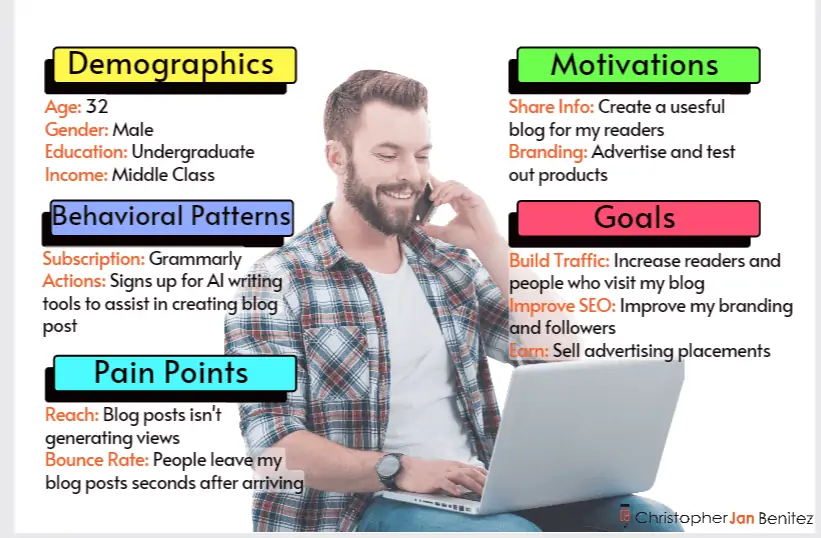Last Updated on 1 year by Christopher Jan Benitez
As a content creator, you know how important it is to engage your audience and keep them returning for more.
But with the constant influx of information and distractions on the internet, it can be challenging to hold your readers’ attention.
One way to tackle this issue is by choosing the correct format for your content.
Should you go for short, snappy pieces that can be consumed quickly?
Or longer, more in-depth articles that delve deeper into a topic?
These are questions that have divided content creators for years.
This article will explore the pros and cons of short-form and long-form content and help you decide the best fit for your brand and audience.
By the end, you’ll clearly understand when to use each type of content and how to maximize its impact.
The Pros of Short-Form Content

Short-form content, such as blog posts, social media posts, and infographics, can be a useful tool in a content creator’s arsenal.
One of the main benefits of short-form content is that it is quick and easy to consume, making it suitable for busy readers with short attention spans.
This type of content is also highly shareable on social media platforms, which can help to drive traffic to your website or blog.
Short-form content is also designed to be easily digestible and straightforward, making it suitable for busy readers who may not have much time to devote to reading.
The brevity of short-form content makes it easy for readers to scan and understand the main points quickly.
This grabs their attention and keeps them engaged, thus increasing the likelihood that they will read and retain the information.
Additionally, short-form content can introduce readers to a topic and drive them to longer, more in-depth content for further exploration.
However, it is important to note that short-form content has limitations, such as a lack of space for detailed information and analysis and the potential to be perceived as shallow or superficial.
The Cons of Short-Form Content
While short-form content has its benefits, it is also essential to consider the potential drawbacks.
One of its main limitations is the limited space for detailed information and analysis.
This can be problematic when dealing with complex or technical topics requiring more in-depth exploration.
Short-form content may also be perceived as shallow or superficial, as it often only touches on the surface of a topic rather than delving into the nuances and subtleties.
The Pros of Long-Form Content
Long-form content, such as long-form articles (even a blog post), ebooks, and white papers, can be valuable to a successful content marketing strategy.
One of its main advantages is that it allows for a more in-depth topic exploration.
This can be particularly useful for complex or technical subjects, as it allows you to delve into the details and provide a comprehensive overview of the subject matter.
Long-form content can also help establish your credibility and authority on a subject, as it demonstrates a commitment to research and an in-depth understanding of the topic.
In addition to its benefits for establishing credibility and authority, long-form content can drive more organic traffic through search engines.
Search engines favor longer, more in-depth content, generally seen as a sign of expertise and authority on a subject.
As a result, long-form content performs favorably on search engine results pages (SERPs), thus improving your rankings and helping you attract organic traffic.
The word count required for you to produce long-form content depends on a myriad of factors. But if you can publish an average length of 1,447 words (at least, according to Backlinko), there’s a good chance it’ll rank on Google.
Finally, long-form content can be more engaging and satisfying for readers, especially those looking to delve deeper into a topic and explore it in greater depth.
This can appeal to readers interested in a subject and want to learn more about it. While long-form content does require a greater time investment from both the creator and the reader, the benefits can make it well worth the effort.
The Cons of Long-Form Content

One of the main disadvantages of long-form content is that it is resource-intensive and takes longer to produce and consume.
This can be a challenge for content creators, who must devote more time and effort to researching and writing longer pieces.
It can also be a challenge for readers, who must set aside a more significant chunk of time to read and absorb the information.
Another potential drawback of long-form content is that it may not be as shareable on social media as shorter, snappier pieces.
With the abundance of content available on social media platforms, it can be difficult to get users to click on and read longer pieces. As a result, long-form content may not be as effective at driving traffic through social media as shorter forms.
Finally, long-form content can be intimidating for busy or casual readers, who may be put off by the prospect of committing a large chunk of time to read.
When to Use Short-Form and Long-Form Content
There are several factors to consider when deciding when to use short-form and long-form content in your content marketing strategy:
Target Audience
Who are you trying to reach with your content? Different types of audiences may have different preferences when it comes to the length and format of content.
So, knowing who your target audience is with your content will help you determine the content length of your piece.
You should have a good handle on your audience’s demographics, behavioral patterns, pain points, and others.

Using the information in the example above, you could say that the audience wants to learn how to write a good blog post to generate more traffic and engage their audience.
From here, you’ll need to create a long-form article that will serve as a great starting point for content creation.
Topic
What are you writing about? Some topics may lend themselves more to short-form content, while others may require a more extended, detailed treatment.
Goals
What do you hope to achieve with your content? Different types of content can be better suited to different goals.
For example, short-form content may be more effective at driving traffic to your website, while long-form content may be better at establishing credibility and authority on a subject.
Your resources
How much time and effort do you have to devote to creating content?
Long-form content can be more time-consuming, so it is important to consider whether you have the resources to commit to it.
Your distribution channels
How will you be sharing your content? Different distribution channels may be more or less suited to different types of content.

For example, short-form content may be more effective on social media.
And, as mentioned, short-form pieces help drive more traffic to your longer content. In this case, you can write a short but complete answer on Quora and then link to your long-form pieces to promote them.
Best Practices for Combining Short- and Long-Form Content in a Content Strategy

There are several best practices for combining short-form and long-form content in a content marketing strategy:
- Use short-form content to introduce readers to a topic and drive them to long-form content for more in-depth exploration. This can be a helpful way to use short-form content to drive traffic to your website or blog.
- Use long-form content to establish credibility and authority on a subject, and then use short-form content to promote and share the longer piece. This can be an effective way to get more mileage out of your long-form content.
- Mix and match different types of content to keep things interesting for your audience. For example, you might alternate between long-form articles and shorter blog posts or use infographics and social media updates to break up longer pieces.
- Use short-form content to drive engagement and build a relationship with your audience, and then use long-form content to provide more in-depth value. This can help to keep your audience engaged and coming back for more.
- Consider using a content calendar to plan your short-form and long-form content. This can help you strike a balance between the two and ensure that you consistently provide value to your audience.
Conclusion
Content marketers must determine the factors that will help them decide between short- and long-form content.
Both types of content have their benefits and drawbacks, and it is essential to find the right balance and choose the best format for your needs.
By considering these factors and following best practices for combining both forms of content, you can effectively use both types of content in your content marketing strategy to engage and delight your audience.

